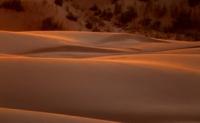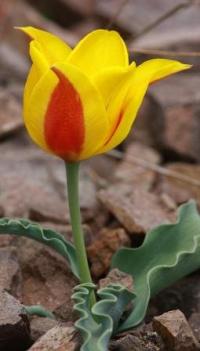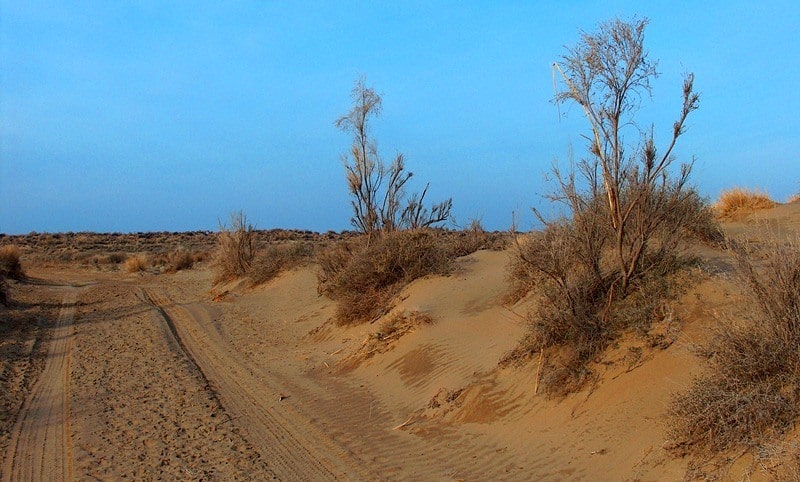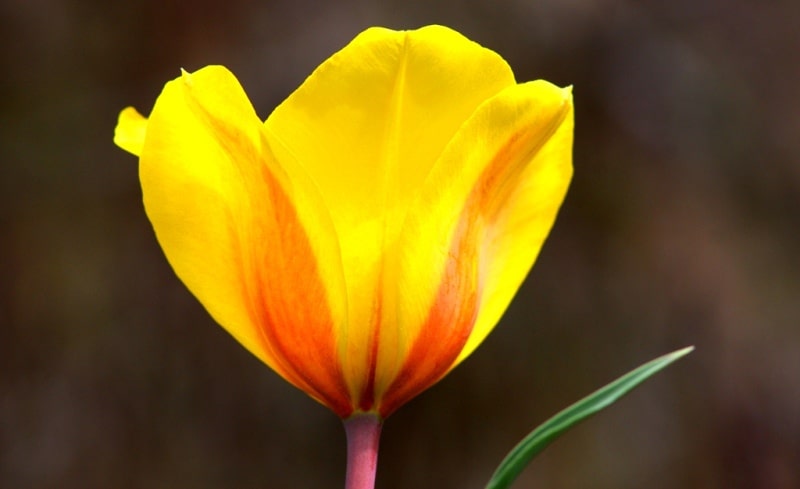Вы здесь
Kyzyl-Kum desert.



Excursion tour in Kyzylkum desert.
“Not all those who wander are lost”
J.R.R. Tolkien.
Geographic tours in Uzbekistan.
The vast interfluve of the Amu-Darya and Syr-Darya, from the spurs of the Pamir-Alai mountainous country (including the Nuratau ridge) to the Aral Sea, is occupied by the sands of Kyzylkum on the territory of the Kyzylorda region of the Republic of Kazakhstan, Navoi, Khorezm, Bukhara, Samarkand regions, the Republic of Karakalpakstan of Uzbekistan and partially in Turkmenistan.
It borders on the Aral in the northwest, the Syrdarya in the northeast, the spurs of the Pamir-Altai and Tien Shan in the southeast and the Amu Darya in the southwest. The surface of the desert has a gentle general slope from the southeast to the northwest, towards the coast of the Aral Sea. It occupies most of the Navoi region.
The name "Kyzylkum" in Turkic means "red sands". The sands here are reddish in color, formed by weathering and winding of bedrock sandy deposits. In the northern, near the Syrdarya strip, which, like the Central Karakum, is an ancient alluvial plain with accumulations of sand resulting from the winding of alluvium, the sands are gray-yellowish.
The area of the Kyzylkums is about 300,000 square kilometers, their surface gradually decreases in the north-west direction from the mountains towards the Aral Sea, from 300 meters above sea level at the foot of Nuratau to 53 meters above sea level at the sea coast.
Geology of Kyzylkum Desert.
According to the geological structure of the Kyzyl Kum, they differ from the Kara Kum in that the folded Paleozoic basement within them is located at a shallower depth, and in the central part, as if piercing the Mesozoic and Tertiary strata, forms low mountains.
The sequence of Quaternary deposits in the Kyzyl Kum was formed somewhat differently than in the Kara Kum. The alluvial material was brought into the desert mainly by the Syr Darya. The composition of the loose Kyzylkum strata differs from similar deposits of the Karakum in greater clay content.
This is explained by the fact that the Syr-Darya deposited large clastic material in the Fergana basin, and carried finer material outside the basin to the Kyzyl Kum. The Ferghana depression, almost closed on all sides and surrounded by high ridges, became a collector of detrital material that was carried down from the ridges and carried into it by the Syr Darya.
The slopes of the Fergana basin were the main source of detrital material transported by numerous rivers that flowed down from them and flowed into the Syr Darya. The Amu Darya did not have and does not have such a reservoir of alluvial deposits.
She carried the erosion products directly to the Karakum and, wandering, deposited them over a large area. The rivers flowing from the steep northern slope of the Kopet-Dag carried the alluvium directly into the Karakum, just like Tejen and Murgab. Despite the general plain of the territory of the Kyzyl Kum, the nature of its surface is very diverse.
The southeastern coast of the Aral Sea is mainly covered with deeply dissected aeolian sands, between them along the ancient channels stretching narrow strips of sandy-clayey, often solonchak plains. Vast spaces are occupied by takyrs, interspersed with massifs of sand, sandy, rather loose surfaces and salt marshes.
A huge part of the surface of the Kyzyl Kum is covered with sandy ridges. The array of ridge sands is intersected by a narrow strip of alluvial plains accompanying the old channels of the Syr Darya. To the northwest of the strip of alluvial plains, sandy ridges are relatively low (10 - 12 meters), to the south their height noticeably increases, reaching 20 - 30 meters, and in some cases even 100 meters.
These ridges are composed of bedrock (tertiary), often exposed from under covering sands, and are similar to the Zaunguz kyrs.
In the central part of the Kyzylkum, low mountains rise: Kuldzhuktaus with a dominant height of 784 meters above sea level, Mamdytau with a height of 888 meters above sea level and Bukentau with a height of 785 meters above sea level.
Near the delta of the Amu Darya is the Sultan-Uizdag ridge with a height of 485 meters above sea level. These mountains are composed of Paleozoic rocks (granites, etc.), strongly crumpled into folds, complicated by faults.
The asymmetry of the folds determines the gradual rise of the southern slopes and the steep character of the northern ones. Minerals have been found in the mountains: asbestos, copper, graphite. In intermountain depressions, coals are associated with Mesozoic rocks.
The history of the development of mountains is common with the history of the development of the Tien Shan, the extreme sections of one of the branches of which they are. The slopes of the mountains are cut by deep ravines - sai. At the foot there are accumulations of coarse clastic material and areas of rocky desert are formed.
The Paleozoic massifs are framed by
The surface of the piedmont plains is covered with rough rubble material, which is replaced by sandy-argillaceous deposits. In plan, the piedmont plains have bizarre outlines, uneven edges are often cut off by ledges - chinks - to the surrounding sands, which lie at a lower level.
Cliff are dissected by dry, short and deep ravines. The low Paleozoic mountains do not have permanent streams. In the spring (March - April), during the period of the greatest amount of precipitation, violent streams flow from the slopes of the mountains and along the ravines. In May, as soon as the rains stop, the streams dry up.
Outcrops of fresh and cold groundwater are common at the bottom of ravines. The region is characterized by closed drainless depressions, the bottoms of which are several tens of meters (up to 200 meters) below the surrounding area. At the bottom of a number of such depressions, strata of table salt are formed.
Between the Amu Darya and the low Paleozoic mountains there is a sandy plain composed of ancient sandy deposits. Sandy ridges fixed by vegetation extend meridionally. On the right bank of the Amu Darya, there are often ridges composed of continental Upper Tertiary deposits, similar to those of the Zaunguz.
From the foothills of the Zeravshan and Gissar ranges in the western direction, gradually decreasing, the piedmont plains stretch - wavy, and then flat, with massifs of sand. At the very foothills, in the upper part, the plains are covered with loess. Numerous hills and hills rise above the plains, composed of bedrock (Mesozoic and Tertiary).
Climate of Kyzylkum desert.
The climate of the northern half of the Kyzyl Kum is generally similar to the climate of the territories located in the northern subzone of deserts, in particular, the climate of Ustyurt. The northern Kyzylkums are characterized by sharply continental climatic conditions, hot summers and severe cold winters.
Western Kyzyl Kum is the most arid part of the plains of Central Asia with an annual rainfall of 80 - 100 mm. The maximum precipitation occurs in spring - March and April (10 - 20 mm), and the minimum - in July and August; there is usually no rain during these months.
In the southern half of the Kyzyl Kum, a stable snow cover is not established, the winter is cold, but milder than in the north; the average January temperature is -4°, and the minimum temperatures are below -30°; in Kazalinsk, respectively -12 and -40°.
The average July temperature in the south of the Kyzylkum reaches +30°, and in the north (Kazalinsk) +26°. The name "Kyzyl Kum" in translation from the Turkic language means "red sands". The sands formed here by the weathering of bedrock sand deposits have a reddish color. In the northern Syr Darya strip, which, like the Central Karakum, is an ancient alluvial plain with sand accumulations resulting from the movement of alluvium, the sands are grayish yellow.
The desert surface has a gentle general slope from the south-east to north-west, to the coast of the Aral Sea. A characteristic feature of the Kyzyl-Kum desert - the existence of isolated low mountains in its central and southwestern parts - lost mountain ridges, these are Bukantau, Dzhetymtau, Tamdytau, Guldzhuktau and others, in the west - Sultanuizdag.
All of them are the lost mountain of the Paleozoic (Hercynian) folded ranges, located on the continuation of the structures of the northern ranges of the Pamir-Alay (Turkestan Range and the Nuratau Range) and elevated by the latest tectonic movements.
The ridges are composed of highly stationed and metamorphosis of Paleozoic schists, limestones, granites, etc. On the tops and ridges of many lost mountain, there are developed leveling surfaces used for rainfed crops.
The slopes of the lost mountain are strongly dissected, at the foot there are plumes of rubble of sand accumulations, which are often the reservoirs of fresh groundwater, which in some places feed the springs supplying the mining settlements.
In the area of lost mountain there are flat hilly elevations and plateaus composed of weak disturbed Cretaceous and Paleogene sedimentary rocks (marls, sands, clays). The presence in the central and southwestern parts of the desert of extensive closed depressions (the valleys of the Karakat and Ayakagytma) is also characteristic.
Most of the Kyzyl-Kum desert is occupied by sand massifs formed by half-fixed sands. The most common sand ridges of the meridional orientation. At settlements and around wells there are flowing, dune sands. A significant array of sand dunes stretched along the Amu Darya.
In most cases, the exposure of the sands is the result of immoderate grazing of vegetation by cattle at watering places, as well as the use of shrubs and saxaul for fuel. In a number of areas, work is being done to strengthen the sands by planting shrubs - dzhuzguna, saxaul, and others.
Barkhan sands in the south of the desert, advancing on the Bukhara and Karakul oases and falling asleep, are now fixed. It created a powerful barrier of greenery (from saxaul and large black saxaul trees) 120 km long. In the Kyzylkum desert, small cattle (mainly karakul sheep) are grazed, as well as camels, horses, and in a smaller quantity - cattle.
The organization of pasture use and the creation of new wells have greatly increased the livestock population. Large artesian basins are found in the central and southwestern parts of the desert. Near the artesian wells in the depressions there are pockets of agriculture, melons and gourds are cultivated, experimental stations have been created, whose work is aimed at providing livestock with additional feed.
The channel from the Chardara reservoir on the Syr Darya, carried out into the depths of the desert, made it possible to master part of the desert lands for rice fields, orchards and vineyards. In the lost mountain mountains of the desert there are a variety of mineral wealth (marble, graphite, turquoise, asbestos, coal, etc.), mines work.
Not so long ago, the Muruntau gold deposit was discovered, where the village of Zarafshan has already grown (“gold-bearing” - in Uzbek). In the south there is a large gas field Gazley. Gas was also found on the southwestern margin of the desert on the right bank of the Amu Darya, near the Farab station.






Authority:
N. A. Gvozdetsky, N. I. Mikhailov. “Physical Geography of the USSR. Asian part. Third edition, revised and supplemented. Moscow "Thought" 1978. http://tapemark.narod.ru/geograf/1_5_5.html
Photo by
Alexander Petrov.







